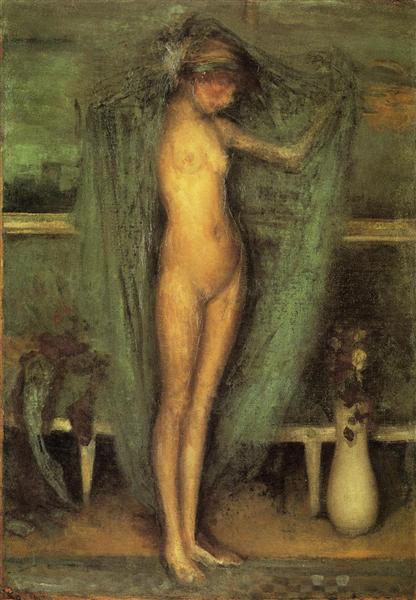Description
The painting "Harmony in blue and gold: the blue girl" of 1901, one of the last great works of the American artist James McNeill Whistler, is presented as a testament of his mastery in manipulation of color and atmosphere, as well as his ability to capture the poetic essence of his subjects. In this work, Whistler explores a delicate palette of blue and golden tones, following his theory of tone and color that seeks a visual symphony similar to musical harmony.
At first glance, the paint offers us the figure of a young girl, dressed in a splendid blue dress, which gently contrasts with the golden and blue background. The figure of the girl, immortalized in a pose of elegant serenity, seems submerged in an almost ethereal atmosphere. This only character captures the viewer's attention with his contemplative gaze and his serene bearing, suggesting deep innocence and tranquility.
The composition of the work is a testimony of Whistler's ability to create a balanced and harmonious image. The use of horizontal and vertical lines guides the view through the canvas, while the ornamental details of the background, which seem to evoke a stylized decorative pattern, add a layer of complexity without distracting from the main subject. This tendency to simplification and minimalism aligns with Whistler's philosophy, who often privileged the suggestion about literal representation.
The color plays a vital role in this painting. The blue, who dominate both the girl's dress and part of the environment, not only provide cohesion, but also transmit a sense of calm and serenity. On the other hand, golden tones inject warmth and luminosity, creating a subtle but significant contrast that enriches the visual depth of the work. This controlled and meticulous use of color demonstrates the influence of Japanese art and oriental aesthetics in Whistler's work, who was known for his fascination towards these artistic traditions.
It is interesting to notice the management of negative space in painting. Whistler leaves broad areas of the composition relatively devoid of details, allowing the viewer's eye to rest and focus more intensely on the interaction between the colors and the central figure. The atmosphere that is created through this approach is almost emblematic of its objective of producing pictorial "harmonies" that are so pleasant for the eye as a melody is for the ear.
While "Harmony in blue and gold: the blue girl" can be among Whistler's less discussed works compared to her most famous portraits as "arrangement in gray and black No. 1" (popularly known as "Whistler's mother" ), This painting remains a crucial demonstration of its artistic approach. Whistler remained consisting of his rejection of explicit narrative and his preference for a more abstract and universal beauty.
For Whistler art and scholars, this work offers a window to the artist's aesthetic concerns at the end of his career. The "blue girl" remains as an enigmatic figure, wrapped in the mystery of a look that seems to look at both the observer and past of the artist himself. In its exploration of harmony through color and shape, Whistler not only created a visually captivating portrait, but a piece that invites a prolonged and deep contemplation of beauty in its purest state.
KUADROS ©, a famous paint on your wall.
Hand-made oil painting reproductions, with the quality of professional artists and the distinctive seal of KUADROS ©.
Art reproduction service with satisfaction guarantee. If you are not completely satisfied with the replica of your painting, we refund your money 100%.

